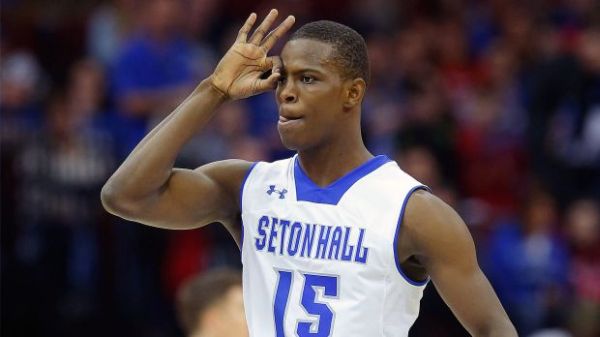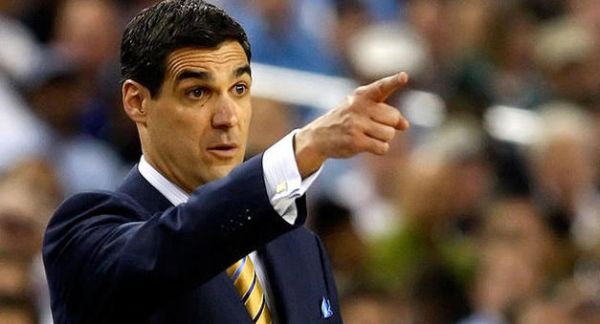Big East’s Burning Questions: NCAA Tournament Edition
Posted by Justin Kundrat on March 16th, 2016With five NCAA Tournament teams seeded anywhere from #2 to a #9, the expectations for the Big East this season are all over the map. Let’s take a look at the single biggest question surrounding the postseason success of each program heading into the first weekend.
Villanova: Can the Wildcats finally break through to the Sweet Sixteen? This narrative has seemingly lasted forever. After a number of exits in the Second Round, many pundits are writing off Jay Wright‘s squad. The reasons are all over the place: a lack of true NBA-level talent; a lack of interior depth; limited athleticism; over-reliance on the three-pointer. But what the narrative fails to capture is that the team’s dynamic continues to evolve with each passing year — players gain experience, develop new skill sets and build cohesion. People desperately wanted to craft the three-point shooting storyline around this year’s team but it simply hasn’t held up. Yes, Villanova shoots threes, but they are rarely contested. They are simply a manifestation of an offense where the primary options are to use Josh Hart in the lane or Daniel Ochefu on the low block. Iowa isn’t the type of team to give Villanova problems, nor is an undersized and poor-shooting Temple team. Expect the narrative to finally unwind this March.
Xavier: Can Chris Mack keep his team under control on offense? Xavier is deep, athletic and one of the best rebounding teams in the country. This combination of attributes enables it to beat most teams through physicality alone, but given the number of post players and capable slashers (Trevon Bluiett and Edmond Sumner) who contribute, it’s surprising that this team is one of the worst in the country in finishing at the rim (251st). It instead tends to derive points from getting to the free throw line, where the Musketeers convert at an above-average rate. But as seen in its three games against Seton Hall, the Musketeers struggle with pressure defense, often settling for long-distance jumpers that limit offensive rebounding opportunities. The result of the pressure is poor decision-making more than turnovers. In its 27 wins this season, the Musketeers’ average free throw rate (FTA/FGA) was 46 percent. In its five losses, this figure was just 32 percent, and with its loss at Villanova excluded, it was 27 percent. This reveals two distinct possibilities: either a lack of foul calls (although its opponents all had above average free throw rates in these games), or a lack of aggressiveness on the offensive end. Xavier is by no means a “jump-shooting team,” so Myles Davis and Sumner need to keep steady and remain under control in the face of defensive-minded teams such as Wisconsin and West Virginia.

With Isaiah Whitehead at the helm, the Hall will have a shot in every game it plays in. (USA TODAY Sports)
Seton Hall: Can the Pirates compete against some of the biggest teams in the country? The committee did Seton Hall no favors by putting the Pirates in the same pod as Gonzaga and Utah, both of which run post-dominant offensive sets. Seton Hall has succeeded with its backcourt all season long: Isaiah Whitehead and Khadeen Carrington are both tremendous dribble-drive guards that get into the lane with ease, but the problems arise against pack-line teams that clog the paint and dare them to shoot. It’s no secret that Seton Hall doesn’t have much frontcourt depth, but the recent play of Ismael Sanogo has compensated somewhat for that, especially when Angel Delgado gets into foul trouble (which is frequently). This shift has worked well in a Big East where most teams play a smaller brand of basketball and stretch the floor with shooting big men, but that won’t work nearly as well against Gonzaga and Utah. Both are very efficient in the paint and adept at avoiding fouls (Utah is first nationally in this respect; Gonzaga is 27th). So while the “get their big men in foul trouble” strategy might seem smart on its face, it won’t be as easy as it seems. The crucial question then becomes how well Seton Hall will hold its own on the boards, and whether Delgado can keep his composure.
Butler: Will they struggle to score in slower-paced games? Butler surprised many observers this season by ramping up its pace of play. While the Bulldogs aren’t the most athletic team around or one that will frequently beat you down the floor in transition, their increased tempo helped in many cases by simply catching the opposing team off guard. Butler rarely fails to take advantage when given opportunities to score — the Bulldogs are careful to take care of the ball and attempt mostly smart, high-percentage shots. To nobody’s surprise, then, Butler’s pace has a strong correlation with the team’s offensive efficiency. Things unfortunately tend to go awry with more deliberate teams. In games with 70 or more possessions, Butler went 14-0 this season. In games with fewer than 70 possessions, the Bulldogs went 7-10. Butler’s potential foes, Texas Tech and Virginia, coincidentally, are two of the slowest teams in the country. Given how successful each team is at containing the pace (Virginia hasn’t played a 70+ possession game all season; Texas Tech hasn’t done so since January), Butler’s key will be finding a way to effectively score in the half-court. That burden will fall on the duo of Kellen Dunham and Kelan Martin.
Providence: Will the supporting cast show up? While Ben Bentil has been grabbing the recent national attention, the rest of the team has sputtered. After falling sick with a stomach virus, Kris Dunn showed flashes of his former self in games against Butler, St. John’s and Creighton before disappearing again versus Villanova. The junior playmaker seems hampered on the defensive end, which is clearly affecting his play on the offensive end. In his first 24 games, he averaged over three steals per game; in his last six contests, that figure has fallen to below one per outing. During his on-floor struggles, Providence has become even more reliant on Bentil for its offense. While they were never a balanced team, Ed Cooley‘s group is at its best when there are multiple options. Ryan Fazekas and Jalen Lindsey have proven at times that they can be dependable shooters and stretch four Rodney Bullock can put points up in a hurry. USC isn’t an elite defensive team but North Carolina certainly is and Providence will need everything it can get out of its supporting cast. Otherwise, these athletic teams will harass Bentil to death and leave its other players open, daring them to make shots.











































